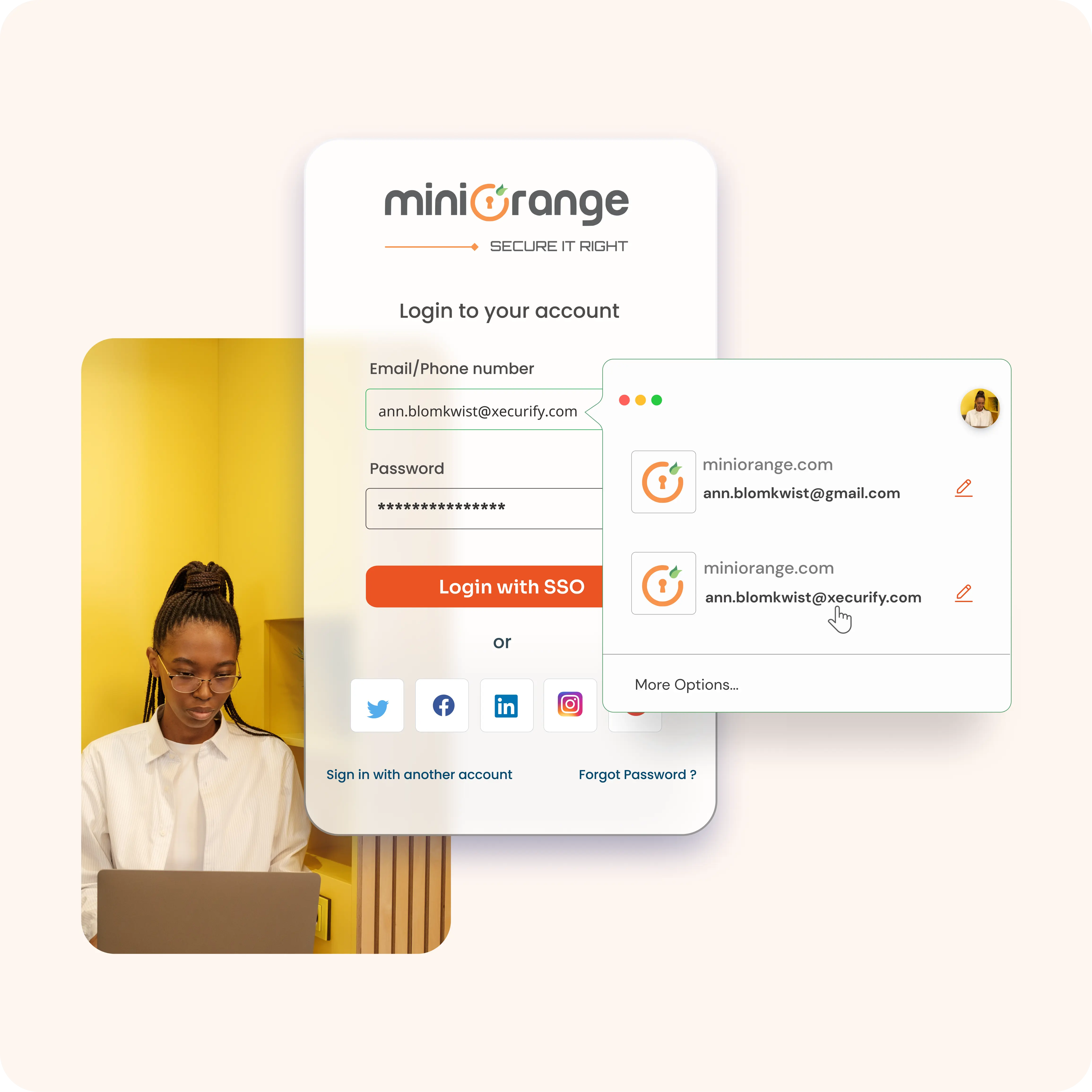Need Help? We are right here!
Search Results:
×SAML (Security Assertion Markup Language) is a widely adopted XML-based standard that enables secure communication between an identity provider (IdP) and a service provider (SP). It facilitates the exchange of authentication and authorization data, allowing users to access multiple applications with a single login. By streamlining the authentication process, SAML enhances security and simplifies user access management in enterprise environments.
SAML Single Sign-On (SSO) leverages the SAML standard to provide users with a seamless login experience across various applications. Once authenticated by the identity provider, users can access all connected services without needing to log in again. SAML SSO not only boosts productivity by reducing login friction but also strengthens security by centralizing user authentication and enabling compliance with industry regulations.
A SAML provider is a system that provides user access to a service. There are two main types of SAML providers: service providers and identity providers. A service provider, such as an app, requires authentication from an identity provider to authorize a user. An identity provider verifies the user's identity and sends this information, along with the user's access rights, to the service provider. miniOrange functions as an identity provider, while platforms like Salesforce and other applications typically act as service providers, relying on an identity provider for user authentication.







When you use miniOrange as your SAML Identity Provider (IdP), the process of logging into various applications becomes seamless and secure. Here’s how it works.
User Attempts to Access an Application
A user tries to access an application (known as the Service Provider or SP) that requires authentication.
Redirection to miniOrange
The application redirects the user to miniOrange, the Identity Provider, to verify their identity.
User Authentication
miniOrange prompts the user to log in (if they havent already). Once the user is authenticated, miniOrange prepares a SAML response containing the user’s credentials and permissions.
SAML Response Sent to Application
The SAML response is securely sent back to the application, confirming the user’s identity and what they are allowed to do.
Access Granted
The application receives the SAML response, verifies it, and grants the user access to the requested resources.

Enable enterprise SAML SSO login with external directories or identity sources like Active Directory, ADFS, HR systems, Microsoft 365, G Suite, social providers, and CRM.
Easily add, remove, or update users and groups, and control app access directly from the miniOrange admin portal, ensuring streamlined management and enhanced security.
Enhance user experience with a custom login/registration page, including multi-language support to personalize the user experience of your workforce, customers, and partners.
Admins can effortlessly customize groups, roles, and permissions and gain user SAML SSO login insights from active usage reports, downloadable in CSV or sync with SIEM.
Comply with GDPR, NIST, PCI DSS, and SOC using SAML SSO. Its standardized protocols help maintain security and regulatory compliance, while monitoring actions help detect and address potential security issues.
Password Manager
Streamlined, secure login process by combining SSO with password management, simplifying credential handling, and reducing IT overhead.
Windows Domain Authentication
Seamless SSO login with Integrated Windows Authentication, eliminating re-entry of credentials, reducing friction, and boosting productivity.
SSO Integration for In-House Apps
Seamlessly integrate SSO with in-house apps built on Spring Boot, Java, PHP, or .NET using miniOrange's custom connectors, ensuring secure access without major system changes.
Adaptive Single Sign-On (SSO)
Identify and prevent unauthorized access and login attempts from hackers with adaptive SSO capabilities that closely monitor user behaviors to adapt to the situation in order to invoke the correct security response.
Passwordless Single Sign-On (SSO)
Enhance security and user experience with passwordless login, reducing phishing risks and password fatigue.

miniOrange provides 6000+ pre-built integrations to securely adopt and deploy Single Sign-On (SSO) service to diverse Cloud-based (SAAS), In-house and On-Premise apps without individually maintaining the integrations.
With pre-integrated SSO service, it gets even easier for enterprises to quickly set up the required app and provide seamless SSO access.
Explore miniOrange app Integration Catalog








*Please contact us to get volume discounts for higher user tiers.
Identity solutions from miniOrange can be easily deployed in your organization's existing environment.

5.0
"SSO for Cloud base app"
It was exceptionally good experience during POC. Team was very helpful right from integration to check the actual output of the product... Read more

5.0
"Seamless SSO Solution with Exceptional Service"
miniOrange offers the best user experience for Single Sign-On (SSO)... Read more

5.0
"Great MFA Product & support"
Overall very good & stable solution. We are using this product for more than 3 years now. Our use case is mostly MFA for VPN. Great Service.
SAML SSO solution helps employees and end-users quickly access their enterprise apps with a single click. This eliminates the inconvenience of managing, remembering, and resetting multiple passwords, thus improving productivity.
SAML SSO authentication enables users to manage individual dashboards and self-reset passwords, eliminating the necessity for IT support. This helps in reducing IT costs.
Enhance user experience with a custom login/registration page, including multi-language support to personalize the user experience of your workforce, customers, and partners.
miniOrange cloud-based SAML SSO solution with competitive pricing allows you to choose your subscription plan based on current requirements and then scale as you grow.
OAuth and SAML are two different protocols used for authentication and authorization in different scenarios. OAuth is primarily focused on delegated authorization, involving the exchange of access tokens between the client application, the resource owner (user), and the resource server (API). SAML, on the other hand, is designed for Single Sign-On (SSO) and federated identity management and operates by exchanging XML-based security assertions between an identity provider (IDP) and a service provider (SP). miniOrange solution supports both SAML & OAuth protocols along with other popular protocols for SSO, MFA & Provisioning.
SAML 2.0 is the upgraded version of the original SAML protocol, which is widely used in enterprise environments and web applications for implementing federated identity management and SSO. SAML 2.0 supports various authentication mechanisms, including username and password, X.509 certificates, and Multi-Factor Authentication. It also allows for attribute-based access control. miniOrange SSO solution supports SAML 2.0 Protocol for SAML Single Sign-On (SSO).
SAML authentication and user authorization are not the same thing. SAML authentication refers to the process of verifying the identity of a user. User authorization, on the other hand, deals with granting or denying access to resources or functionalities based on the authenticated user's permissions. Once a user's identity has been authenticated, the service provider (SP) or application determines what the user is authorized to do and what resources they can access. miniOrange SAML SSO solution provides both Authentication and Authorization capabilities.
Let’s take the example of an employee at a large company trying to access their professional email account on the company domain from a mail service provider like Outlook or Gmail. When they log in, the email system doesn't have their credentials. It redirects them to your company's login page. After entering the username and password, the SAML Identity Provider generates a SAML token (XML document) that confirms your identity. It sends this token back to the email system, which validates it and grants them access without needing a separate login. SAML login enables Single Sign-On, enhancing security and user convenience across various services.
Yes, SAML Single Sign-On (SSO) can be used for both web and mobile applications. It provides a standardized authentication mechanism that works across various platforms, ensuring a seamless and secure user experience regardless of the device or application type.

Our Other Identity & Access Management Products